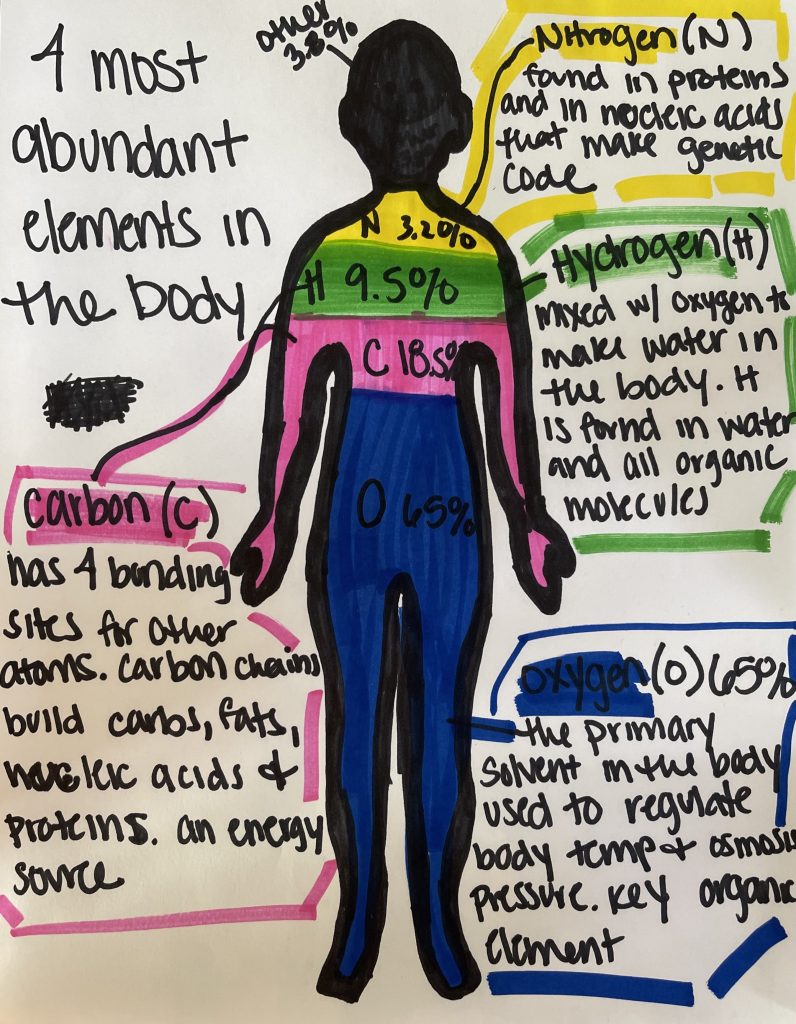When looking at the human body and all of its functions, we often look at the body systems. But what really makes all of these systems and what are their building blocks? I wanted to devote my STEAM project to looking not only as something that is looked over, but something that is misinterpreted as the building blocks of our bodies.
The 4 most abundant elements in the body make the body able to function the way it does. But it is not often seen that way. Without oxygen, nitrogen, hydrogen and carbon in our bodies, a lot of what we do and how we function would not be possible.
In an article found about elements in human tissues, it explained how elemental composition of organisms is just as important and that the product of an organism’s growth contains biological and elements structures. (Popovic 1). We often see things such as osmosis, bone regeneration or nerve impulses and all of those are derived or continue because of the elements pulsating throughout our bodies.
Carbon in the body has 4 different bonding cites for other atoms. Its carbon chains are used to build thins like carbohydrates, fats, lipids, nucleic acids and even proteins. Carbon is also used as a main energy source for the body. Oxygen in our body is the primary solvent and is used in the regulation of body temperature and osmotic pressures. It is also the key organic element in the body. Hydrogen is used and mixed with oxygen to make water that make us a large percentage of our body weight. It is found in water and all organic molecules in the body. Nitrogen is found in proteins throughout the body and is also found in nucleic acids that make up our genetic code.
The 4 main abundant elements in our bodies make up 92.2% and the rest such as phosphorous, calcium, potassium, and sodium make up the other 3.8%. We often want to look at the bigger picture of how things function but the building blocks are always at the foundation.
Works Cited
POPOVIC, Marko E., and Mirjana MINCEVA. “Thermodynamic Properties of Human Tissues.” Thermal Science, vol. 24, no. 6B, Nov. 2020, pp. 4115–4133. EBSCOhost, doi:10.2298/TSCI200109151P.


Jordyn’s project looked at the main four elements that our found in our bodies. The art component of the project shows the human body and the percents of each element that makes up our body. When looking at how our body functions, we often look at the biological level: osmosis, nerve impulses etc…, but we often overlook the chemical level which our body is created and from which all of our functions are able to be carried out. Our body is made up of mainly four elements: nitrogen which is found in proteins and nucleic acids, hydrogen which combines with oxygen to form water, carbon which builds carbon chains found in carbohydrates, fatty, amino, and nucleic acids. Lastly, our most abundant element, oxygen, which is the primary solvent of the body and is used to regulate our body temperature and osmosis. The other 3.8% of elements found in our body are: phosphorus, calcium, potassium, and sodium. Jordyn’s project is a good reminder that all the biological processes which happen in the human body would not be possible if not for these four elements.